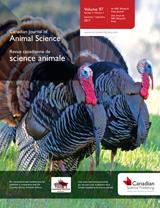The impact of two different grain screening pellets (GSP) on the chemical profile of feces, feed digestibility, growth performance, and carcass traits of feedlot heifers was measured. Near-infrared spectroscopy (NIRS) was used to predict differences in the chemical composition and energy content of GSP and feces. Heifers (445 ± 35.5 kg) were allocated to 15 pens (10 heifers pen-1) and offered three diets: (1) 76% barley grain (dry matter basis; control); (2) light screening pellets (LSP); and (3) heavy screening pellets (HSP), where GSP replaced 20% barley grain. In controls, fecal starch tended to be higher (P = 0.09) and neutral detergent fiber (NDF) lower (P < 0.01) than heifers fed GSP diets. Fecal nitrogen (N) and ether extract (EE) were also higher (P < 0.05) in heifers fed the control compared with GSP diets. The average daily gain (ADG) of heifers fed LSP tended to be lower (P < 0.06) than the control diet. Gain:feed in controls was higher (P < 0.02) than in those fed GSP diets. Both ADG and G:F were positively associated with fecal N and starch, but negatively associated with NDF. Compared with direct measurements, NIRS over predicted total digestible nutrient (TDN) content of GSP, but did predict most differences in chemical composition.
How to translate text using browser tools
23 December 2016
Digestibility and growth performance of feedlot cattle fed pelleted grain screenings
L.J. Jancewicz,
D.J. Gibb,
M.L. Swift,
G.B. Penner,
T.A. McAllister
ACCESS THE FULL ARTICLE
It is not available for individual sale.
This article is only available to subscribers.
It is not available for individual sale.
It is not available for individual sale.
bovins en parcs d’engraissements
efficience alimentaire
feed efficiency
feedlot cattle
near-infrared spectroscopy
pastilles de criblures (résidus de criblage)
screening pellets





